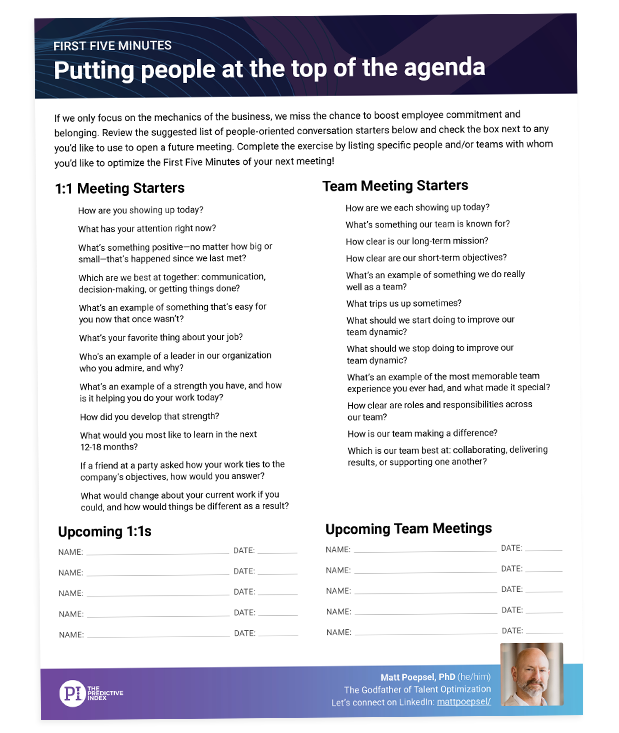Some things just seem made for one another. Peanut butter and jelly. Movies and popcorn. Summer days and sunroofs. The combination enhances our experience in a way that’s almost like magic.
So why are so many many meetings anything but magical?
One reason is that we tend to run what I call “either or” meetings. We can talk about the work we need to do OR we can talk about people-related matters like personal development, and building on human connection. Not both. This is like saying, “Would you like macaroni or cheese?”
In many organizations, the work dominates the agenda of most meetings. It’s easy to understand why. There’s always a need for status updates, deliverables, and troubleshooting. Throw in constant organizational change, inevitable surprises, and time pressure, and there’s certainly a lot to talk about!
Making time for the human element
If we push the people bits to the periphery, however, we invite new problems. A McKinsey study found that 51% of exiting employees cited a lack of belonging as a key contributor to their departure decision. All work and no connection makes workers restless.
In response to this, many managers schedule dedicated development sessions with their direct reports. These offer a chance to put work aside and chat about individual needs.
There are a few challenges with this approach:
- They are often too infrequent to create continuity.
- Work often seeps into these sessions anyway, while the reverse is rarely true.
- They seem artificial, since people matters are inexorably linked to the work.
It’s this last realization that led me to create a new technique I’d like to share with you. I call it the “First Five Minutes.”
Whether you have a 30-minute or a 60-minute meeting on the books, can you take just the first five minutes to focus on the people part? I promise you can have the entire rest of the meeting to talk about worky-work stuff. You’ll be amazed at the result. Even better—this technique is equally applicable to 1:1 meetings and team sessions.
We can use our First Five Minutes to accomplish so many things:
- Show our people we care about them.
- Foster connection and belonging.
- Discover something we didn’t know before.
- Deepen our relationships.
- Garner trust and safety.
As leaders, we must deliver the results—this will always be true. But we’re also expected to heighten the engagement of our team members, keep them securely committed to pursuing the mission, and encourage them to do the hard work needed to reach their next level.
When we take the First Five Minutes of our meetings to prioritize the often overlooked people matters, we find that we still have plenty of time to pursue the work.
Without doing so, we create distance, invite risk, and squander a precious opportunity.
If I’ve convinced you to try using the First Five Minutes of your next 1:1 or team meeting, you may be wondering, “Okay, but what do I say?” Don’t worry! I’ve got you covered.
I find that as leaders, questions help us open a door and create space. That’s why I’ve created a handy worksheet full of questions you can use to kick off your next 1:1 or team meeting. I’ve even included a simple accountability planner to help you follow through on your great intentions.
Some things are better together. I’ll have the macaroni and cheese, thank you. Nowhere is this more true than in our meetings.
How will you combine the people and the work during the First Five Minutes of your next meeting?









